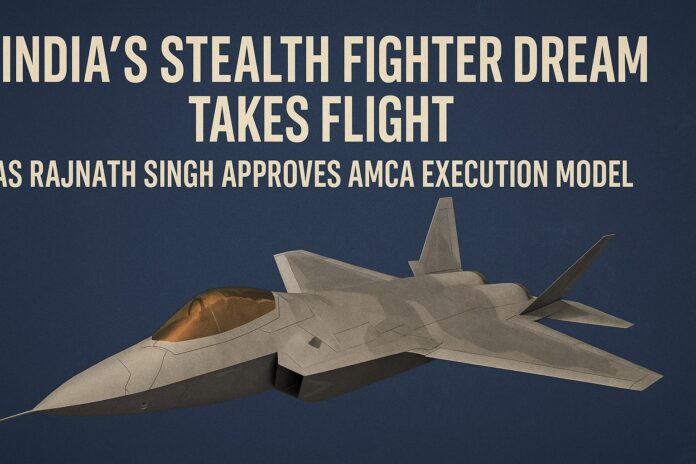India’s long-awaited fifth-generation stealth fighter project, the Advanced Medium Combat Aircraft (AMCA), is now officially in motion. Defence Minister Rajnath Singh has greenlit the execution model that will guide the programme’s development, ushering in a new chapter for indigenous aerospace capabilities and domestic defence manufacturing.
Led by the Aeronautical Development Agency (ADA), the AMCA initiative will operate through a public-private partnership framework designed to attract a broad spectrum of Indian industry players. Whether as individual firms, joint ventures, or consortia, participants will compete on equal footing—provided they are Indian entities complying with national regulations. An Expression of Interest (EoI) for the aircraft’s development phase is expected to be issued soon.
The Cabinet Committee on Security had cleared the programme earlier on March 7, 2024, allocating roughly Rs 15,000 crore for the design and prototype development. The AMCA, intended as a medium-weight stealth fighter, will feature cutting-edge elements such as internal weapons carriage, sensor fusion, and a serpentine air intake, key to reducing radar signatures. However, initial production is not expected before 2035, according to current projections.
This fifth-generation platform will gradually follow the Indian Air Force’s induction of the Tejas Mk-1A and Mk-2 jets, both crucial as the IAF contends with an operational shortfall. Against an authorised strength of 42.5 squadrons, the force is currently operating just 31, raising concern amid the strategic pressures from China and Pakistan.
At present, the IAF has inducted 40 Tejas Mk-1 jets powered by GE-F404 engines. Deliveries for the next batch, 83 Mk-1A variants under a Rs 46,898 crore contract, are scheduled to begin shortly. Plans are also underway for an additional order of 97 Mk-1A jets, estimated at Rs 67,000 crore.
In parallel, negotiations have commenced for the production of an advanced variant of the BrahMos missile in Uttar Pradesh, as India and Russia explore deeper industrial collaboration under the ‘Make in India’ banner.
As the AMCA programme gains momentum, it not only represents a technical leap for the IAF but also reflects India’s strategic intent to build and own critical defence technologies. The skies may not see the AMCA in full operational strength for another decade, but its foundations are finally in place.
Is it too little, too late?
India’s long-awaited approval of the AMCA programme is of unmatched importance, but it raises pressing questions about timing and urgency. Cleared by the Cabinet Committee on Security in March 2024, the AMCA is envisioned as a fifth-generation stealth fighter, equipped with advanced sensors, supercruise capability, and internal weapons carriage. Its development is backed by a budget of Rs 15,000 crore for the prototype phase. However, the jet is not expected to enter production before 2035.
By then, global military aviation may have moved into sixth-generation platforms. China and the United States already operate fifth-gen aircraft in substantial numbers, while India struggles to maintain just 31 fighter squadrons against the sanctioned strength of 42.5. The Indian Air Force is currently bolstered by only 40 Tejas Mark-1 jets and awaits deliveries of the Tejas Mark-1A variant, with Mark-2 and AMCA meant to follow. This staggered approach underscores the time crunch.
Critically, India’s AMCA ambitions are coming at a point when even existing regional adversaries are expanding their fleets with newer technologies. Meanwhile, delays in indigenous engine development mean that the AMCA may initially rely on imported propulsion systems, dampening the self-reliance narrative.
In this context, the green light to AMCA appears more like an overdue necessity than a forward-leaning leap. While it reflects India’s commitment to aerospace sovereignty, the timeline and geopolitical realities leave a lot to be figured out.
How can India transition from AMCA to 6th-gen aircraft?
Realistically, India can do everything, but the timelines will have to get messy. In the first phase, India must focus on completing the development and deployment of the AMCA. Production is expected to begin around 2032, with initial deliveries projected by 2035. The AMCA will introduce key capabilities such as stealth, sensor fusion, and advanced avionics into the Indian Air Force. This phase is critical for refining stealth materials, integrating electronic warfare systems, and establishing a reliable manufacturing ecosystem. Expanding production capacity will be vital to avoid delays seen during the Tejas programme, ensuring faster induction and operational feedback for future platforms.
The second phase involves research and development of sixth-generation technologies. As other nations test hypersonic engines, AI-enabled avionics, and drone swarming, India must invest heavily in these domains to remain competitive. Developing AI-powered sensors and decision-support systems will be essential, along with strengthening domestic capabilities in radar and electronic warfare. International collaboration with countries like France, the UK, or Japan can help bridge capability gaps and accelerate learning. India must also initiate indigenous efforts in directed energy weapons, an emerging area in next-generation air combat.
The final phase will involve the design and production of India’s first sixth-generation fighter. Lessons from AMCA will inform this effort, which must incorporate drone teaming, adaptive engines, and network-centric combat features. A strong industrial base and private sector involvement will be key to timely development, with a target of achieving operational readiness by 2055.
With US and China already ahead, India needs to pick the pace. This approval is a little late but will prove to be crucial.



